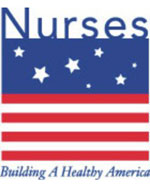Nurses Building a Healthy America
 "Nurses: Building a Healthy America" is the 2009 theme for National Nurses Week, and it reflects the commitment nurses make every day in their communities to protect the public's health. Meet a few CDC nurses, and learn about some of their non-traditional roles.
"Nurses: Building a Healthy America" is the 2009 theme for National Nurses Week, and it reflects the commitment nurses make every day in their communities to protect the public's health. Meet a few CDC nurses, and learn about some of their non-traditional roles.
"Nurses: Building a Healthy America" is the 2009 theme for National Nurses Week, and it replicates the work of CDC and ATSDR's 160 nurses. Their varied backgrounds, titles, and responsibilities mirror the many doors open to nurses worldwide in non-traditional roles as researchers, scientists, educators, managers, analysts, and more.
As stated by the American Nurses Association, "… [nursing] is an art and a science, and a profession that embraces people with varied interests, strengths, and passions because of the many opportunities the profession offers." During National Nurses Week, May 6–12, we would like you to meet a few of our nurses. Several are active duty Commissioned Corps officers in the U.S. Public Health Service (USPHS), one of America's seven uniform services.
Nurses Working with Displaced Populations and Complex Emergencies
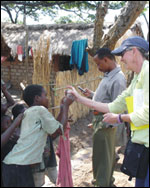
Holly Williams assesses the residential areas in a Tanzania camp to determine if there are mosquito breeding areas nearby. The children ask to see pictures.
As a member of the International Emergency and Refugee Health Branch, USPHS CAPT Holly Williams, PhD, MN, RN, works with displaced populations. Often, these people are refugees who have crossed an international border because of war and civil strife. Malaria is Williams' expertise, and her job includes assisting the United Nations High Commissioner for Refugees (UNHCR), the UN agency responsible for refugees and, to some degree, internally displaced persons, by providing malaria control assessments in refugee camps.
CAPT William's job also involves assisting UN agencies, such as the World Health Organization and UNHCR, with establishing policy for malaria control in complex humanitarian emergencies. In addition to rapid field assessments, engaging in policy discussions, and operational research, her assignment entails teaching both university-level and international courses. During any year, she is overseas about 35 percent of the time.
In addition, CAPT Williams serves as the Preventive Medicine Branch Director for the USPHS Rapid Deployment Force 3 (RDF 3), based in Atlanta. RDF 3, on call every five months, is trained to respond to public health emergencies such as natural disasters and national security events, as requested by the Department of Health and Human Services. Part of preventive medicine's role is ensuring infection control and facility maintenance.
Nurses Working on CDC Emergency Health Alerts: Epi-X and HAN
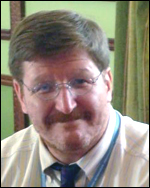
Jim Schwendinger facilitates at a recent risk communications workshop in Kenya.
As the lead for the Epidemic Information Exchange System (Epi-X) Team, Jim Schwendinger, RN, MSN, MPH, CCRN, ANP-C, brings his nursing education and emergency department experience to many aspects of the operation — from the community and patient-education framework to the advanced practice clinical perspective. Epi-X provides a web-based solution for secure and rapid communication of preliminary public health information between CDC and states. Often this information is provided at the beginning and early stages of an outbreak or disaster, such as the 2009 H1N1 flu (swine flu) national response. With early notification through Epi-X, CDC and states can try to get ahead of a problem before it impacts more people, families, and communities.
"I meet daily with the three Epi-X health communication specialists to review new and ongoing information of a public health nature,” explains Schwendinger. We determine which stories or events might require further investigation, either at the state level or from CDC experts.
In addition to Epi-X, Schwendinger manages the Health Alert Network (HAN) database, a CDC information and communication system. Both are the responsibility of the Epi-X team within CDC's National Center for Health Marketing. These teams, including Epi-X, staff the CDC Joint Information Center in times of public health emergencies.
"From the broad experience nursing has given me, as well as the mindset nurses need to have, I can adapt to any situation," he explains. "Nurses have historically had to emulate adaptability in their profession. Being able to bring the philosophy of nursing into emergency communications and response adds a valuable construct to CDC's response and effectiveness."
Nurses Working with Tribal Health
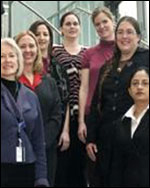
Myra Tucker (second from the left) stands with Tribal colleagues at the Biannual Tribal Consultation Meeting.
In looking back at 2008, USPHS CAPT Myra Tucker, BSN, MPH, tribal liaison in the Division of Reproductive Health (DRH), agrees it was an exceptional year. She works with American Indian/Alaska Native (AI/AN) mothers and children. CAPT Tucker was the inspiration behind the first Maternal and Child Health Journal dedicated to AI/AN, Research for Maternal and Child Health Practice in American Indian and Alaska Native Communities.
In addition to the journal publication, 48 AI/AN tribal leaders joined 75 CDC/ATSDR leadership and program representatives for the first Biannual Tribal Consultation Meeting. Among them was USPHS CAPT Pelagie (Mike) Snesrud, BSN, Office of Minority Health and Health /Disparities. Snesrud shared the importance of these meetings.
"They reflected CDC's understanding of the special legal and political relationship it holds with sovereign Tribal nations," explains CAPT Snesrud. "CDC leadership's commitment to uphold the tenets of Tribal consultation and its commitment to work with Tribal leaders, communities, and organizations to eliminate AI/AN health disparities and positively impact the health of Native people wherever they may reside is absolutely critical."
Nurses Working as Epidemiologists
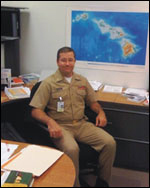
Brant Goode begins his CDC career as an Epidemic Intelligence Service officer.
USPHS LCDR Brant Goode, RN, MPH began his CDC career as an Epidemic Intelligence Service (EIS) officer assigned to the North Carolina Division of Public Health in 2004. After completing his EIS Fellowship in 2006, he remained in North Carolina as a CDC Career Epidemiology Field Officer assigned to facilitate the state's pandemic influenza planning efforts.
LCDR Goode's impact included providing direction to the state's 86 local health departments to develop a state plan with a consistent epidemiological approach.
"We worked to emphasize preparedness among vulnerable groups," explains Goode, "and to provide input into national vaccination prioritization efforts."
Today, as an active duty Commissioned Corps officer, LCDR Goode is located with the Hawaii Department of Health, where he shares his epidemiological perspective and guidance to Hawaii's Public Health Emergency Preparedness Branch. He is coordinating a full-scale mass prophylaxis exercise and a pandemic flu triage and medication delivery project.
More Information
Current Features
Need info on a
different topic? See
